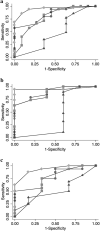Clinical performance of lung ultrasound in predicting ARDS morphology
- PMID: 33779834
- PMCID: PMC8006629
- DOI: 10.1186/s13613-021-00837-1
Clinical performance of lung ultrasound in predicting ARDS morphology
Abstract
Background: To assess diagnostic performance of lung ultrasound (LUS) in identifying ARDS morphology (focal vs non-focal), compared with the gold standard computed tomography.
Methods: Mechanically ventilated ARDS patients undergoing lung computed tomography and ultrasound were enrolled. Twelve fields, were evaluated. LUS score was graded from 0 (normal) to 3 (consolidation) according to B-lines extent. Total and regional LUS score as the sum of the four ventral (LUSV), intermediate (LUSI) or dorsal (LUSD) fields, were calculated. Based on lung CT, ARDS morphology was defined as (1) focal (loss of aeration with lobar distribution); (2) non-focal (widespread loss of aeration or segmental loss of aeration distribution associated with uneven lung attenuation areas), and diagnostic accuracy of LUS in discriminating ARDS morphology was determined by AU-ROC in training and validation set of patients.
Results: Forty-seven patients with ARDS (25 training set and 22 validation set) were enrolled. LUSTOT, LUSV and LUSI but not LUSD score were significantly lower in focal than in non-focal ARDS morphologies (p < .01). The AU-ROC curve of LUSTOT, LUSV, LUSI and LUSD for identification of non-focal ARDS morphology were 0.890, 0.958, 0.884 and 0.421, respectively. LUSV value ≥ 3 had the best predictive value (sensitivity = 0.95, specificity = 1.00) in identifying non-focal ARDS morphology. In the validation set, an LUSV score ≥ 3 confirmed to be highly predictive of non-focal ARDS morphology, with a sensitivity and a specificity of 94% and 100%.
Conclusions: LUS had a valuable performance in distinguishing ARDS morphology.
Keywords: ARDS; ARDS morphology; Bedside tests; Lung ultrasound; Point of care diagnostic tests; Respiratory monitoring.
Conflict of interest statement
The authors report the absence of conflicts of interest related to the submitted work.
Figures




Similar articles
-
Lung Ultrasound Assessment of Focal and Non-focal Lung Morphology in Patients With Acute Respiratory Distress Syndrome.Front Physiol. 2021 Sep 14;12:730857. doi: 10.3389/fphys.2021.730857. eCollection 2021. Front Physiol. 2021. PMID: 34594240 Free PMC article.
-
[The value of lung ultrasound score on evaluating clinical severity and prognosis in patients with acute respiratory distress syndrome].Zhonghua Wei Zhong Bing Ji Jiu Yi Xue. 2015 Jul;27(7):579-84. doi: 10.3760/cma.j.issn.2095-4352.2015.07.008. Zhonghua Wei Zhong Bing Ji Jiu Yi Xue. 2015. PMID: 26138420 Chinese.
-
Clinical performance of lung ultrasound in predicting time-dependent changes in lung aeration in ARDS patients.J Clin Monit Comput. 2023 Apr;37(2):473-480. doi: 10.1007/s10877-022-00902-5. Epub 2022 Aug 8. J Clin Monit Comput. 2023. PMID: 35939164 Free PMC article.
-
Assessment of the Effect of Recruitment Maneuver on Lung Aeration Through Imaging Analysis in Invasively Ventilated Patients: A Systematic Review.Front Physiol. 2021 Jun 4;12:666941. doi: 10.3389/fphys.2021.666941. eCollection 2021. Front Physiol. 2021. PMID: 34149448 Free PMC article.
-
Lung imaging: how to get better look inside the lung.Ann Transl Med. 2017 Jul;5(14):294. doi: 10.21037/atm.2017.07.20. Ann Transl Med. 2017. PMID: 28828369 Free PMC article. Review.
Cited by
-
Reliability and clinical correlations of semi-quantitative lung ultrasound on BLUE points in COVID-19 mechanically ventilated patients: The 'BLUE-LUSS'-A feasibility clinical study.PLoS One. 2022 Oct 14;17(10):e0276213. doi: 10.1371/journal.pone.0276213. eCollection 2022. PLoS One. 2022. PMID: 36240250 Free PMC article.
-
Prone positioning in ARDS patients supported with VV ECMO, what we should explore?J Intensive Care. 2022 Oct 4;10(1):46. doi: 10.1186/s40560-022-00640-5. J Intensive Care. 2022. PMID: 36195935 Free PMC article. Review.
-
Old and New Definitions of Acute Respiratory Distress Syndrome (ARDS): An Overview of Practical Considerations and Clinical Implications.Diagnostics (Basel). 2025 Jul 31;15(15):1930. doi: 10.3390/diagnostics15151930. Diagnostics (Basel). 2025. PMID: 40804893 Free PMC article. Review.
-
Lung Ultrasound in Children with Cystic Fibrosis in Comparison with Chest Computed Tomography: A Feasibility Study.Diagnostics (Basel). 2022 Feb 1;12(2):376. doi: 10.3390/diagnostics12020376. Diagnostics (Basel). 2022. PMID: 35204467 Free PMC article.
-
Lung ultrasound score for the assessment of lung aeration in ARDS patients: comparison of two approaches.Ultrasound Int Open. 2024 Oct 21;10:a24218709. doi: 10.1055/a-2421-8709. eCollection 2024. Ultrasound Int Open. 2024. PMID: 39444846 Free PMC article.
References
LinkOut - more resources
Full Text Sources
Other Literature Sources
Medical

